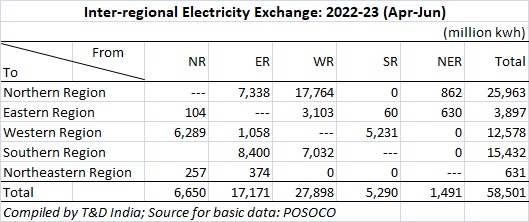The total volume of interregional electricity transfer rose marginally by 2.2 per cent year-on-year during the first quarter of FY23.
According to statistics released by the National Load Dispatch Centre (NLDC), total interregional electricity transfer stood at 58,501 million kwh (million units or MU) during the first quarter (April to June) of FY23, as against 57,234 MU in the same quarter of FY22.
Here are some highlights:

Imports by WR rose sharply from 7,703 MU in Q1 of FY22 to 12,578 MU in Q1 of FY23. Much of this increase came about due to a significant growth in imports by WR from SR. This metric rose to 5,231 MU in Q1 of FY23 from 1,846 MU in Q1 of FY22.
Exports from Southern Region (SR) were much higher during Q1 of FY23, ostensibly due to higher renewable energy injection in the ISTS network. SR exported 5,290 MU of electricity in Q1 of FY23, as against 1,865 MU in Q1 of FY22.
Exports from Northeastern Region (NER) also recorded growth owing to higher hydropower generation. NER exported 1,491 MU in Q1 of FY23 as compared with 721 MU in the same period of FY22.
Read also: Interregional Transfer Capacity Crosses 1 Lakh Mw
Net importers & exporters
During Q1 of FY23, three regions – ER, WR and NER – were net exporters of electricity whereas the other two – NR and SR – were net importers. Traditionally, WR and NR used to be considered as consumption centres whereas the remaining three regions were generation centres. However, over the years, the dependence of WR on other regions appears to be diminishing.
The largest net importer during Q1 of FY23 was NR – at 19,313 MU. Net imports by SR stood at 10,141 MU. WR was the largest net exporter to the tune of 15,320 MU followed ER with 13,274 MU.
India’s National Grid, with a capacity of over 114 GW, facilitates seamless transfer of electricity between the five regional grids—NR, WR, ER, SR and NER. Nearly 85 per cent of this interregional transfer capacity (or 97 GW) comes through transmission systems owned by Power Grid Corporation of India Ltd (PGCIL).


